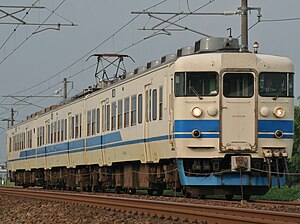413 series
| 413 series | |
|---|---|

Set B9, August 2010
|
|
| In service | March 1986–Present |
| Constructed | 1985-1989 |
| Number built | 31 vehicles (11 sets) |
| Number in service | 31 vehicles (11 sets) |
| Formation | 3 cars per trainset |
| Fleet numbers | B01-B11 |
| Operator(s) |
JNR (1986–1987) JR-West (1987–) Ainokaze Toyama Railway (2015–) |
| Depot(s) | Kanazawa |
| Line(s) served |
Hokuriku Main Line Ainokaze Toyama Railway Line |
| Specifications | |
| Car body construction | Steel |
| Car length | 20,000 mm (65 ft 7 in) |
| Width | 2,950 mm (9 ft 8 in) |
| Doors | 2 pairs per side |
| Maximum speed | 110 km/h (70 mph) |
| Electric system(s) | 1,500 V DC, 20 kV AC, 60 Hz overhead catenary |
| Current collection method | Pantograph |
| Track gauge | 1,067 mm (3 ft 6 in) |
The 413 series (413系 Yonhyaku-jūsan-kei?) is a Japanese dual-voltage (1,500 V DC and 20 kV AC 60 Hz) electric multiple unit (EMU) train type first introduced by Japanese National Railways (JNR) in March 1986, and later operated on local services on the Hokuriku Main Line by the West Japan Railway Company (JR-West) from 1987 and also by the third-sector railway operating company Ainokaze Toyama Railway from March 2015. The units were built by re-using the underframes, bogies and electrical equipment from former 471 series and 473 series express-type EMUs with new suburban type bodies based on the design of the 417 series EMUs introduced in 1978.
JR-West trainsets are used on the Nanao Line, Hokuriku Main Line, and IR Ishikawa Railway.Ainokaze Toyama Railway trainsets are used on the Ainokaze Toyama Railway, IR Ishikawa Railway, and Echigo Tokimeki Railway.
As of 1 April 2016[update], all 31 of the 413 series cars built are in service, with six three-car sets (including two 455 series cars) operated by JR-West and five three-car sets operated by Ainokaze Toyama Railway.
...
Wikipedia
